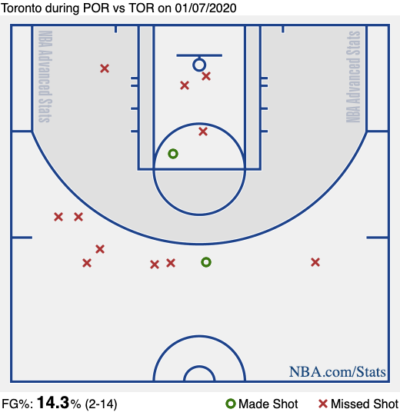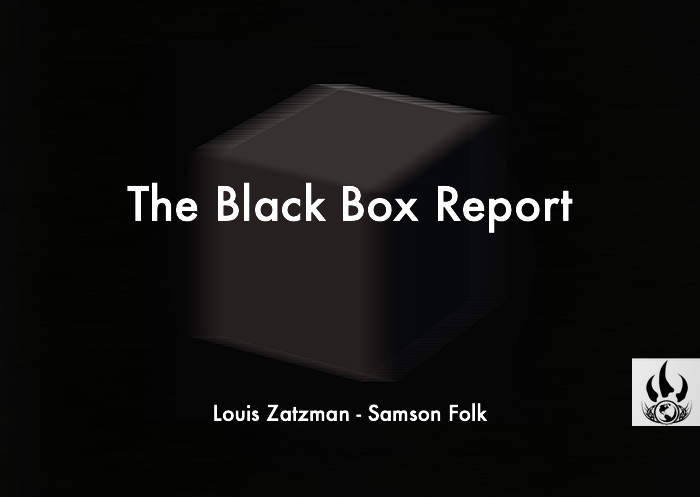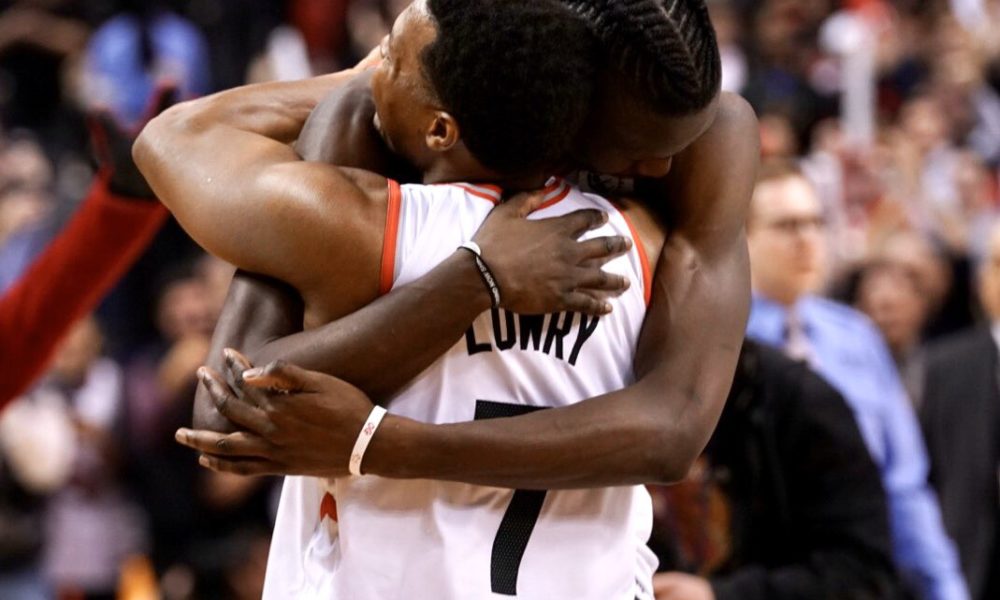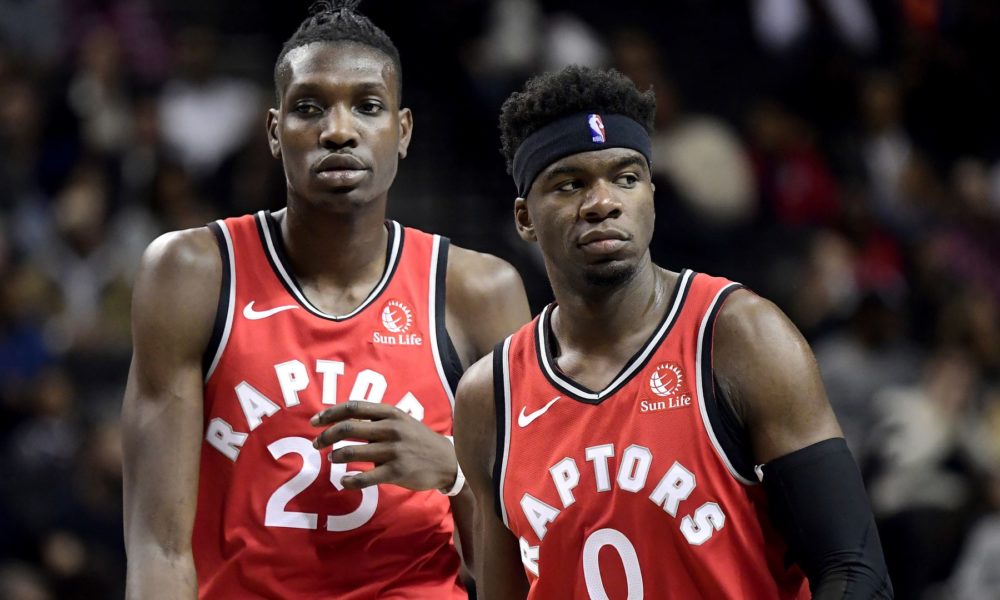The Raptors’ games against the Blazers and Hornets were fairly symmetrical, with the road team trailing for much of the game, only to come back and win when a triple from the home team failed to drop at the buzzer. It just so happened that the Raptors won against the Hornets and lost to the Blazers. That’s not a bad back-to-back, considering Toronto’s extenuating circumstances.
The explanation for this weekly column at Raptors Republic, called The Black Box Report, is fairly simple. Is it a literary journal? Maybe; it sure sounds like it. If it were, I would probably read it. There would be stories about the marginalized and written-off returning to succeed in the very name of his detractors, like Jesse Owens, or to a much, much lesser extent Pat McCaw. Unfortunately, this is not that journal. This column is for me and Samson Folk to simultaneously look forwards and back, explicating the under-examined and trying to explain what went, goes, and maybe even will go, on under the hood. The black box is the vessel inside of which all information is stored, and it’s known for its opacity. Hopefully, this column can add some transparency to what actually puts the points on the board.
Looking Back – Folk
Games:
6:00 pm EST on Saturday January 4 @ the Brooklyn Nets – 121-102 W
7:00 pm EST on Tuesday January 7 against the Portland Trail Blazers – 101-99 L
7:00 pm EST on Wednesday January 8 against the Charlotte Hornets – 112-110 W
It’s a Trap!

It’s particularly cruel that Fred VanVleet’s injury came in his 29-point effort against the Nets, wherein he played the perfect compliment to Lowry’s hard-charging style and necessitated the Nets defense to treat the Raptors offense as if it were anything close to egalitarian. The Raptors have been one of the most trap-heavy teams in the NBA this season, and given their current roster and injury woes, it’s been a viable option defensively. They’ve been able to punch up against ill-prepared teams and overwhelm stars with regularity, and that’s why it left such a sour taste in my mouth to watch that strategy employed against the Raptors with such success.
The Blazers recognized the Raptors vulnerable dependency on Lowry’s creation and keyed in on it. Whether he was knifing into the paint against 3 players, or they were hedging and scrambling across the top of the 3-point line to deny him a look, he drew all of the defensive focus. There’s a stark contrast between Lowry’s shot chart in the final 12 minutes of the win against the Nets and the second half in the loss to the Blazers.
With Rondae Hollis-Jefferson, Patrick McCaw and the slumping OG Anunoby providing approximately no spacing, the Blazers pushed Lowry deeper and deeper. We watched Damian Lillard, Spencer Dinwiddie, and Devonte’ Graham operate in the drive and kick game to create offense for their teams, but that playstyle wasn’t viable with the roster around Lowry. Passes were made out of the traps and the ancillary pieces of the Raptors needed to get all the way to the rim or no where at all, so the chasm of open floor in the middle of the Blazers defense was worthless to the Raptors. So, the Blazers got more aggressive in pushing up on Lowry. Lowry responded to this in the same manner as James Harden and Steph Curry have in the past – by launching from farther and farther out.

7 (!) of Lowry’s second half attempts from behind the arc would register as deep, and that’s reflected in his 1-8 performance (2-14 altogether). The Raptors offense sputtered and died in the second half, putting up a paltry 43 points, giving up a 14-point lead and falling to their first sub-.500 team of the season. Now juxtapose that with VanVleet’s 8-11 (22 points) performance in the second half of the Nets game – created with Lowry’s gravity and VanVleet’s terrific relocation – Terence Davis’ sterling 2-2 performance from downtown in overtime vs. the Hornets – an overtime that didn’t even require a shot attempt from Lowry – and Anunoby’s superb finish to the game. It’s clear that the Raptors are devoid of secondary options, and unless players like Davis and Anunoby can continue to step forward as offensive difference makers consistently, the Raptors are going to struggle to create against the trap. Stay tuned.
Springy, bouncy basketball – where did you go?
What have the Raptors replaced their shooting with? Surely it’s something? Doing deep dives week after week on different teams it’s easy to see that a deficiency in one area often leads to proficiencies in others. The big question has always been what things does a team want to be proficient at, and what are the most painful deficiencies. The Raptors have run into a very painful deficiency: shooting. And they’ve picked up a very common proficiency with teams that struggle to score: lots of offensive rebounding.
Long gone are the days of the mini lineups. Pascal Siakam’s shooting has been an incredible development, and Rondae Hollis-Jefferson has eaten up a lot of those minutes, spending the majority of them hunting offensive rebounds. Oh right, VanVleet, Marc Gasol, and Norman Powell are injured as well. Replacing them is Chris Boucher, Oshae Brissett, Terence Davis II for the most part, all of them possessing length and bounce. And they all like to direct that length and energy towards the offensive glass. The Raptors averaged 15.3 offensive rebounds a game last week – and rebounded 30-percent of their misses – which would rank them as the NBA’s greatest team in that area by some measure.
This fantastic offensive rebounding overlaps with horrible TS% and an appreciably slower pace than when the Raptors are at their best. Not to mention, even though the Raptors profile as a much better offensive rebounding team in this stretch, they still have problems closing out defensive possessions. The Raptors are supposed to run, they’re great at it. And quite frankly they need it to supplement their offense.
If we look back to the 5-game winning streak (Dec. 14 – 22) the Raptors were playing faster, shooting much better, getting to the line much more often, and leaving the offensive glass on the back-burner. They had a much healthier squad, and were better equipped to play the way that they’re meant to.
I’m saying all this, and it sounds a little bit negative, but it’s actually quite positive. The Raptors have taken G-League players and asked them to carry the load of NBA rotation players. That has manifested in different ways, rarely in the skill department, but this team continues to provide meaningful production in any stat that one would consider to be “hustle”. VanVleet, the former G-Leaguer, is top-5 in the NBA in deflections. With that tiny wingspan, VanVleet is getting his hand on more basketballs than almost any other player in the league. The Raptors end of bench players have no doubt adopted this mentality and applied it to their own games. So while the Raptors tread water, trying to tease NBA skills out of players who have never been at that level, and ask them to leave it all out on the floor night after night (just like their point guard Kyle Lowry does), it’s important to remember there’s a reprieve coming. And we should appreciate the work that’s been put in thus far. Especially since the Raptors were oh so close to a 3-0 week. This team is a marvel to watch.
Looking Forward – Zatzman
Games:
6:00 pm EST on Sunday January 12 against the San Antonio Spurs
8:00 pm EST on Wednesday January 15 @ the Oklahoma City Thunder
7:00 pm EST on Friday January 17 against the Washington Wizards
Reinforcements could actually be on the way
First and foremost, it looks like Siakam’s injury, as reported by the Sun’s Ryan Wolstat, was less severe than originally believed. Wolstat hypothesized that Siakam could be back on the floor as early as this Sunday, although he said that would be unlikely. Even if he’s not back to play against DeMar DeRozan, Jakob Poeltl, and the Spurs, he could be back at some point this week. Nurse reported before Toronto’s loss to the Portland Trail Blazers that Norman Powell will be back “soon.”
The Raptors have exactly one player who can create his own shot in any situation at the moment, and that’s Kyle Lowry. However, Lowry probably shouldn’t be playing 40 minutes a game and putting the entire team’s offense on his shoulders. That’s not ideal for the present, but it’s especially not ideal for the playoffs, when Toronto will want a healthy and rested Lowry to slot into a secondary or even tertiary role and destroy defenses at moments that he chooses. That’s what happened last playoffs, and that’s what Toronto could simulate this playoff run, again.
If Siakam and Powell come back soon, Toronto’s offense can rely on far more diverse, high-powered sets in coming games. Toronto will be facing the Spurs (2oth-ranked half-court defense, per Cleaning the Glass), Thunder (13th-ranked half-court defense), and Wizards (30th-ranked half-court defense) this week. If Toronto does return to partial health, you can expect some high-scoring games from Toronto, and potentially a 3-0 week.
Can corner triples call the conclusions?
The last time the Raptors played the Thunder, Oklahoma City was without two of their most important offensive players in Dennis Schroder and Danilo Gallinari. Shai Gilgeous-Alexander and Chris Paul went supernova in their stead, combining for 57 points, 10 assists, and 18 rebounds.
Darius Bazley, a 32.5 percent shooter on the year, shot four-of-seven from deep. Aside from him, and of course Gilgeous-Alexander and Paul, the Thunder went a tremendous 0-of-15 from deep. That’s important.
Toronto spent the first half of the game pinching in from the corner on Gilgeous-Alexander and Paul drives. When they beat their initial defenders — usually Fred VanVleet and Patrick McCaw — they saw two or even three bodies at the rim. They spent the first half kicking out to the corner, only for their open teammates to let them down. 14 percent of Oklahoma City’s shots in the game were corner triples, which is a 94th-percentile rate. However, they only shot 33.3 percent on those shots, which is a 36th-percentile rate. Non-Gilgeous-Alexander and Paul Thunder players scored 22 points in the first half and 19 in the second. The only difference was that the stars passed less in the second half, kept the ball for themselves, and shredded the Raptors’ defense. They passed up those open corner triples in favour of more mid-range looks, and they made enough of those to win.
How does Toronto do better this time around? Well, VanVleet will most likely be out, so he can’t spend time guarding Gilgeous-Alexander or Paul. McCaw and Kyle Lowry did pretty bad jobs at the point of attack, too. When the Thunder’s two deadly guards were guarded by bigger defenders, however, the tables were turned. Per nba dot com’s matchup data (which is always unreliable, but still sketches a broad point nonetheless,) Gilgeous-Alexander and Paul shot a combined one-of-four in 7.0 possessions when guarded by OG Anunoby. Size is the way to threaten driving specialists and mid-range artists. The Raptors should play huge, and keep any two of Anunoby, Rondae Hollis-Jefferson, Chris Boucher, or even Oshae Brissett on the floor at all times. Those four would probably be the best defenders on Gilgeous-Alexander and Paul. Toronto should help liberally on drives and let Oklahoma City’s secondary shooters launch away from the corners.
Unfortunately for Toronto, both Schroder and Gallinari have returned from injury since that Raptors game. Though Gallinari has missed some time since, it’s likely that both will play. They are both deadly shooters from the corners. However, the Raptors have done a good job this season giving up corner triples to opponents’ least-threatening shooters. The Raptors have to make sure they don’t help from any of Gilgeous-Alexander, Paul, Schroder, or Gallinari. That’s hard, but it’s doable.
So, a few predictions. One: the Thunder take 15 or more corner triples. Two, they shoot a horrible percentage on them. The Raptors should pinch in from the corner on drives by Gilgeous-Alexander or Paul, and they should not hesitate to leave almost any of their teammates. The Raptors should do a better job of defending the Thunder this time around. The thing is, at 6.6 percent, the Thunder are actually 24th in frequency of corner triples in the league. That’s not great, and Toronto forcing their lesser shooters to launch shots that aren’t too common in their offensive scheme would be a win for the Raptors.
That could actually be a common theme for the week beyond just the Thunder game. Washington (26th) and San Antonio (28th) are two of the only teams who take a lower frequency of corner triples than the Thunder. San Antonio shoots them well (sixth in the league, at 41.7 percent), but Washington (18th at 38.5 percent) and especially Oklahoma (dead last, 30th, at at bizarre 32.3 percent) do not.
Opponents’ corner triples, both in terms of frequency and accuracy, could be the deciding factor in multiple games this week.
Whether the Raptors can actually score enough to top the Thunder this time around, let alone the Spurs and Wizards, will probably depend on how much they can hit the offensive glass, or who’s available in the lineup. To both those points, please refer to the sections above.
Have a blessed day – Samson




